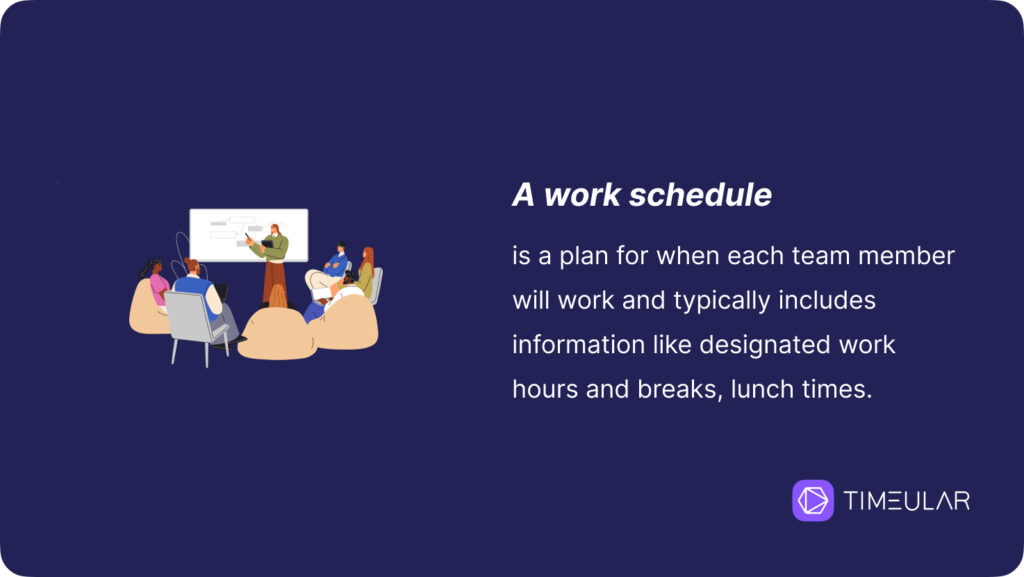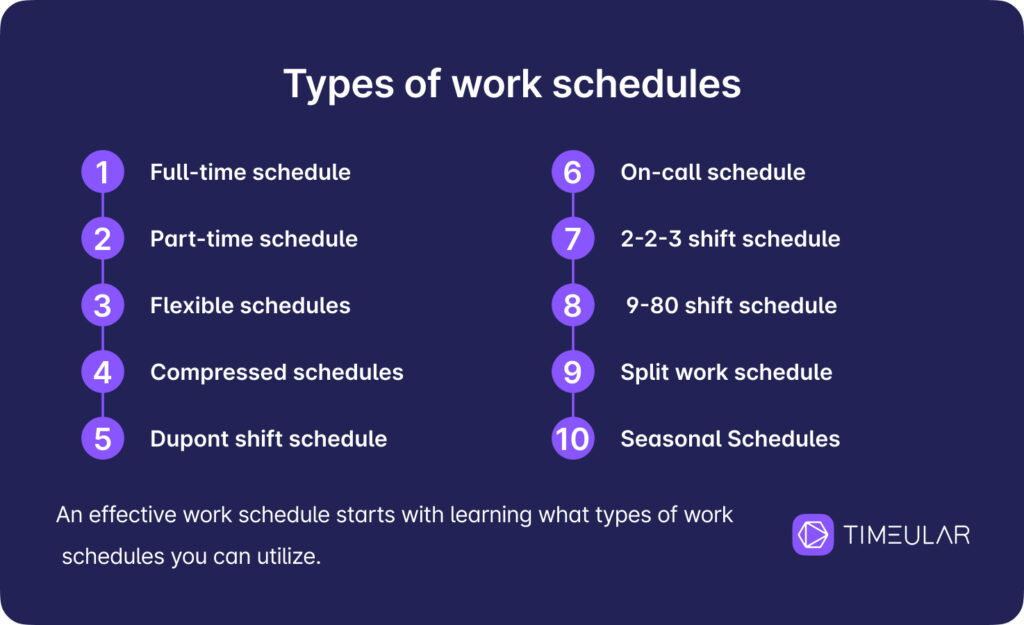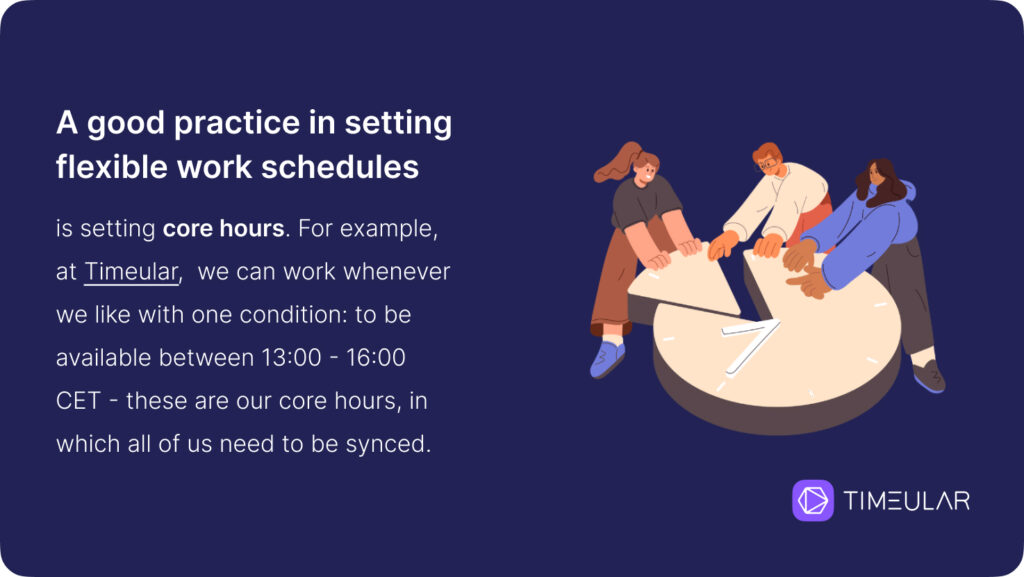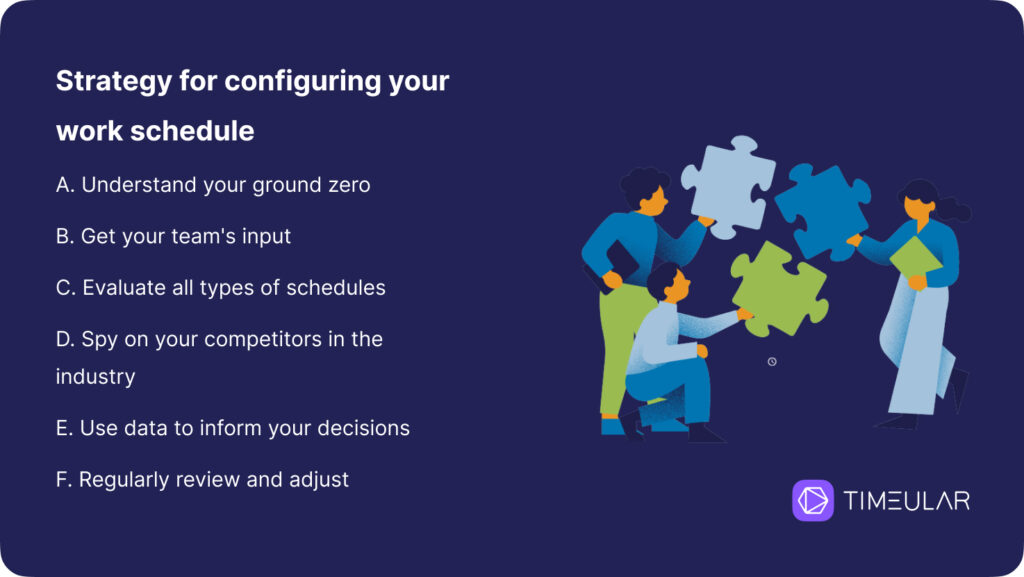Arbeitsplan: Arten, Tipps und Strategien zur Erstellung
Zufriedene Kunden, reibungslose Abläufe, hohe Produktivität und Rentabilität sowie das Wohlbefinden der Mitarbeiter. Es liegt auf der Hand, dass Sie all diese Ziele in Ihrem Unternehmen erreichen wollen, und ein Arbeitsplan ist aus gutem Grund erforderlich. Wenn er gut gemacht ist, wirkt er wahre Wunder.
Die Erstellung von Arbeitsplänen, die alle zufrieden stellen, ist jedoch eine Herausforderung. Um erfolgreich zu sein, muss man eine scheinbar magische Kombination von Zutaten verwenden. In diesem Artikel gehe ich auf die verschiedenen Arten von Arbeitszeitplänen ein und zeige, wie man sie so gestaltet, dass sie für die Mitarbeiter attraktiv und für das Unternehmen effizient sind.

Sorge dafür, dass deine Zeit gut genutzt wird, indem du sie mit automatischen Zeiterfassungs-Apps erfasst und verwaltest.
TLDR
Eine ausgewogene Gestaltung der Arbeitszeiten Ihrer Mitarbeiter ist ein Gewinn für beide Seiten: Ihre Mitarbeiter sind zufriedener, engagierter und produktiver, und Ihr Unternehmen erhält seine dringend benötigte Währung: Rentabilität. Das finden Sie in diesem Artikel:
Verstehen, was ein Arbeitsplan ist und warum er wichtig ist
Entdecken Sie, welche Arten von Arbeitszeitplänen Sie an Ihr Unternehmen anpassen können
Lernen Sie Strategien und Tipps, die Ihnen helfen, Ihren Arbeitsplan zu gestalten
Was ist ein Arbeitsplan?
Arbeitspläne wurden erstellt, um sicherzustellen, dass Ihr Team den Anforderungen Ihres Unternehmens gerecht wird. Mit anderen Worten: Es ist wichtig, dass Ihr Team zur richtigen Zeit am richtigen Ort ist, damit die Dinge reibungslos laufen.
Ein Arbeitsplan ist ein Plan, der festlegt, wann die einzelnen Teammitglieder arbeiten. Er enthält in der Regel Informationen wie die festgelegten Arbeitszeiten, Pausen, Mittagszeiten und andere Details zu den Arbeitsaktivitäten. Er ist wie eine Karte, die zeigt, wer wann arbeitet und was er während seiner Schicht zu tun hat.
Bitte beachten Sie: Es gibt noch mehr Arbeitsgewohnheiten, die zu einem erfolgreichen Unternehmen führen. Erforschen Sie sie alle!

Genauso wie Suchmaschinen Algorithmen verwenden, um zu verstehen, was die Nutzer wollen, verwenden Unternehmen Arbeitspläne, um ihre Abläufe sowohl auf die Bedürfnisse der Mitarbeiter als auch auf die Unternehmensziele abzustimmen. Wenn Sie einen Arbeitsplan erstellen, füllen Sie nicht nur Zeitfenster aus. Sie überlegen, wie Sie die Produktivität maximieren, die Präferenzen der Mitarbeiter berücksichtigen und sicherstellen können, dass Ihr Unternehmen seine betrieblichen Anforderungen erfüllt.
Die Erstellung von Arbeitsplänen hat also alles damit zu tun, den Menschen zu verstehen und zufrieden zu stellen - das ist etwas, das die Dinge ins rechte Licht rücken sollte.
Denken Sie daran, dass Sie auch wissen müssen, wie Sie bei der Arbeit manchmal Nein sagen können.
Arten von Arbeitsplänen
Um einen effektiven Arbeitsplan zu erstellen, muss man zunächst wissen, welche Arten von Arbeitsplänen es gibt. Wenn dies nicht ausreicht, können Sie sicher einen eigenen erstellen, aber das Rad neu zu erfinden, kann zeitaufwändig sein. Ein Arbeitsplan ist ein sich ständig verändernder Prozess. Er entwickelt sich mit Ihrem Unternehmen, und Sie müssen immer die Bedürfnisse Ihrer Mitarbeiter und das Wachstum des Unternehmens im Auge behalten.
Wussten Sie, dass wir bei einer 40-Stunden-Woche 71,5 % unserer Zeit im Jahr bei der Arbeit verbringen? Ich habe dieses Thema in dem Artikel über die Anzahl der Arbeitstage im Jahr ausführlicher behandelt.
Ich möchte Ihnen 10 Arten von Arbeitszeitplänen vorstellen:

1. Vollzeitplan
Der 8-Stunden-Tag von Montag bis Freitag ist die häufigste Art von Arbeitszeitplan, der oft als fester Arbeitszeitplan bezeichnet wird. In der Regel umfasst diese Art von Arbeitszeitplan 40 Stunden pro Woche mit einer regulären Arbeitszeit von 9 bis 17 Uhr, aber das hängt von der jeweiligen Branche ab.
Das Beste an festen Zeitplänen ist die Tatsache, dass sowohl die Mitarbeiter die Vorhersehbarkeit eines festen Zeitplans haben, als auch Ihr Unternehmen eine verlässliche Verfügbarkeit während der Hauptgeschäftszeiten.
2. Teilzeitplan
Teilzeitbeschäftigte bevorzugen vielleicht einen alternativen Arbeitsplan, da sie so ihr Privatleben und ihre familiären Verpflichtungen besser in Einklang bringen können. Für Ihr Unternehmen kann ein optimaler Arbeitsplan bedeuten, dass Sie Spitzenzeiten abdecken, ohne sich auf eine 40-Stunden-Woche festzulegen.
Mit solchen flexiblen Arbeitszeitplänen können Unternehmen die Arbeitskosten kontrollieren und gleichzeitig wichtige betriebliche Erfordernisse abdecken. Diese Art von Arbeitszeitplan variiert zwischen 20 und 30-35 Stunden pro Woche und kann ein fester Zeitplan sein oder nicht, und es liegt im Ermessen des Unternehmens oder des Arbeitnehmers, wie viele Stunden er arbeiten soll.
Übrigens ist Teilzeitarbeit oft die beste Lösung für Freiberufler. Viele der Freiberufler, die ich kennengelernt habe, sagten, je mehr sie ihre Honorare erhöhten, desto mehr begannen sie mit einem gesunden Arbeitsplan.
- Probieren Sie es aus: Zeiterfassungs-App für Freiberufler
3. Flexible Zeitpläne
Die so genannte flexible Arbeitszeitgestaltung hat in den letzten Jahren an Beliebtheit gewonnen. Und die Frage ist, warum auch nicht? Solange die Arbeitnehmer arbeiten und ihren Verpflichtungen nachkommen, sollten sie arbeiten dürfen, wann immer sie produktiv sind.
Hilfreich für eine flexible Arbeitszeitgestaltung ist jedoch die Festlegung von Kernarbeitszeiten.
Nehmen wir unser Beispiel: Bei Timeularkönnen wir arbeiten, wann immer wir wollen, allerdings unter einer Bedingung: Wir müssen zwischen 13:00 und 16:00 Uhr MEZ verfügbar sein - das sind unsere Kernzeiten, in denen wir alle an einem Tag synchronisiert sein oder Anrufe tätigen müssen, und die restlichen Stunden liegen in unserem Ermessen.

4. Komprimierte Zeitpläne
Stellen Sie sich vor, Sie könnten eine ganze Woche Arbeit in weniger Tagen erledigen. Ein Traum!
Das ist ein komprimierter Arbeitsplan: längere Arbeitszeiten an vier statt an fünf Tagen. Diese Art von Arbeitszeitplan wird auch als 4-10-Schichtplan bezeichnet. Mit diesem komprimierten Zeitplan bleiben die Work-Life-Balance des Arbeitnehmers und die Abläufe des Unternehmens vorhersehbar, da die Arbeitszeiten festgelegt sind.
5. Dupont Schichtplan
Der Dupont-Plan ist eine komplexere Art von Programm, das nach dem Modell eines rotierenden Schichtplans funktioniert . Er wird häufig in Unternehmen oder Branchen eingesetzt, die rund um die Uhr arbeiten, wie z. B. im Gesundheitswesen, bei der Polizei, in der Gastronomie und im verarbeitenden Gewerbe, da sie rund um die Uhr besetzt sein müssen.
Der Dupont-Schichtplan besteht also aus einem 8-Wochen-Zyklus mit 12-Stunden-Schichten. Es ist wichtig zu wissen, dass die Mitarbeiter in einer solchen Schicht in der Regel längere Pausen bekommen, um ihre Produktivität zu erhalten und die Burnout-Rate zu senken.
Bei der Wechselschichtarbeit wird 4 Tage am Stück gearbeitet, gefolgt von 3 freien Tagen, dann 3 Tage arbeiten, 1 Tag frei, dann 3 Tage arbeiten und 3 Tage frei. Dieser Zyklus sorgt dafür, dass die Mitarbeiter sich ausruhen können, aber es gibt keine Kontrolle darüber, ob sie Früh- oder Spätschichten haben.
6. Bereitschaftsdienstplan
Der Bereitschaftsdienst wird häufig im Gesundheitswesen, bei Notdiensten oder in Online-Shops geleistet, dierund um die Uhr erreichbar sein müssen. Diese Art von unregelmäßigen Arbeitszeiten kann die Vereinbarkeit von Beruf und Privatleben erschweren, da jeder, der Nachtschichten oder einen Tag Bereitschaftsdienst hat, kurzfristig zur Arbeit erscheinen muss.
Wenn Ihr Unternehmen also eine unmittelbare Reaktion auf dringende Bedürfnisse erfordert, könnte dieser unvorhersehbare Arbeitsplan zu Ihnen passen.
7. 2-2-3-Schichtplan
Eine weitere alternative Lösung bestand darin, 12 Stunden in einem Zyklus von 2 Tagen am Tag, 2 Tagen frei und 3 Tagen am Tag zu arbeiten, der alle zwei Wochen wiederholt wird. Dieser Zeitplan hilft dabei, ein gutes Gleichgewicht zwischen Arbeit und Privatleben zu halten, ermöglicht aber auch eine kontinuierliche Abdeckung des Geschäfts. Dieser Arbeitsplan wird auch als Panama-Zeitplan bezeichnet.
- Lesen Sie mehr über den 2 2 3-Zeitplan.
8. Schichtplan 9-80
Dieser innovative Zeitplan ermöglicht es den Mitarbeitern, 80 Stunden an neun statt der üblichen zehn Tage zu arbeiten, was zu einem langen Wochenende alle zwei Wochen führt. Das ist eine ziemlich kreative Lösung für Arbeitnehmer, die einen flexibleren Arbeitsplan als den Standardarbeitsplan wünschen.
9. Geteilte Arbeitszeiten
Bei einer geteilten Schicht arbeiten die Beschäftigten an einem einzigen Tag in zwei getrennten Schichten, oft mit einer größeren Pause dazwischen. Sie wird häufig im Gastgewerbe und im Kundendienst eingesetzt, wo die Nachfrage während der Frühstücks- und Abendessenszeiten am höchsten ist, aber dazwischen abnimmt.
Die Arbeitszeiten der Mitarbeiter in geteilten Schichten sind in der Regel von 7 Uhr morgens bis 11 Uhr morgens und dann wieder von 16 Uhr bis 20 Uhr abends.
10. Saisonale Zeitpläne
Saisonpläne eignen sich für Unternehmen, die im Laufe des Jahres mit Nachfrageschwankungen konfrontiert sind, wie z. B. Einzelhandelsgeschäfte während der Ferienzeit oder Ferienanlagen während der Hauptreisemonate. Bei dieser Art von Zeitplan können Sie vorübergehend zusätzliches Personal einstellen, um eine erhöhte Arbeitsbelastung zu bewältigen.
Ein Skigebiet könnte beispielsweise in den Wintermonaten mehr Personal einstellen und im Sommer weniger Personal beschäftigen. Andernfalls könnte das Skigebiet das ganze Jahr über einen Overhead an Vollzeitkräften haben, was die finanzielle Nachhaltigkeit beeinträchtigt.

Strategie und Tipps zur Gestaltung Ihres Arbeitsplans
Um den besten Arbeitsplan für Ihr Team, Ihre Branche und Ihr Unternehmen zu erstellen, müssen Sie einige wichtige Faktoren berücksichtigen. Beachten Sie die folgenden Punkte:
A. Verstehen Sie Ihren Ground Zero
Beginnen Sie damit, die besonderen Anforderungen Ihres Unternehmens zu verstehen und zwei klare Ziele vor Augen zu haben: Bewertung der betrieblichen Anforderungen und Ermittlung der Spitzenzeiten.
Um eine Antwort zu finden, sollten Sie sich folgende Fragen stellen:
Können wir die Nachfrage mit unserem derzeitigen Angebot befriedigen?
Wann haben Sie den höchsten Kundenverkehr in Ihrem Online-Shop?
Wann erhalten Sie die meisten Serviceanfragen?
Was übermitteln Ihre Verkaufsdaten?
Ist Ihr Unternehmen in einer betriebsintensiven Branche tätig, die eine 24/7-Abdeckung benötigt?
Haben Sie einen saisonalen Bedarf, z. B. im Sommer, im Winter oder nur während des Black Friday?
B. Holen Sie die Meinung Ihres Teams ein
Wenn Sie Ihren Mitarbeitern einen neuen Arbeitszeitplan aufzwingen, kann sich dies negativ auf die Produktivität des Unternehmens auswirken. Daher ist es am besten, die Präferenzen der Mitarbeiter bei der Arbeitszeitgestaltung zu erörtern. Sie müssen nicht mit jedem das 1:1 besprechen; eine Umfrage würde genügen. Stellen Sie Fragen wie:
Fühlen Sie sich wohl bei der Arbeit am frühen Morgen, am späten Abend oder bei Nachtschichten?
Gibt es Tage oder Zeiten, an denen Sie nicht zur Arbeit erscheinen können?
Gibt es gesundheitliche oder persönliche Gründe, die sich auf Ihre Fähigkeit, bestimmte Stunden zu arbeiten, auswirken?
Wie zufrieden sind Sie mit Ihrem derzeitigen Arbeitsplan?
Haben Sie Vorschläge zur Verbesserung unserer derzeitigen Terminplanungspraxis?
Was halten Sie von der Möglichkeit, in Bereitschaftsdiensten zu arbeiten?
Wussten Sie, dass Feedback eine der besten Möglichkeiten ist, die Motivation Ihrer Mitarbeiter zu erhalten?

Sorge dafür, dass deine Zeit gut genutzt wird, indem du sie mit automatischen Zeiterfassungs-Apps erfasst und verwaltest.
C. Bewerten Sie alle Arten von Zeitplänen
Es gibt keine Einheitslösung oder einen idealen Arbeitsplan. Bewerten Sie die verschiedenen Arten von Arbeitszeitplänen, die ich Ihnen vorgestellt habe, und überlegen Sie, wie diese mit den Anforderungen Ihres Unternehmens und den Präferenzen Ihrer Mitarbeiter übereinstimmen.
D. Spionieren Sie Ihre Konkurrenten in der Branche aus
Wenn Ihre Konkurrenten in ihrem Geschäft erfolgreich zu sein scheinen, dann ist es nicht verkehrt, wenn Sie versuchen zu verstehen, wie sie die Arbeitsplanung angehen. Wenn Sie erfahren, dass ein anderes erfolgreiches Unternehmen aus Ihrer Branche Mitarbeiter für ein paar Stunden einstellt (z. B. in Teilzeit), während Sie Vollzeitkräfte einstellen, dann bedeutet das, dass sie ein Geheimnis haben, auf das auch Sie sich bewerben müssen.

E. Nutzen Sie Daten als Grundlage für Ihre Entscheidungen
Sobald Sie einige Planungspraktiken angewendet haben, müssen Sie feststellen, was funktioniert und was nicht. Halten Sie nach Mustern Ausschau, die auf eine effektive Zeitplanung hindeuten, und nach Kennzahlen, die für die Produktivität und das Wohlbefinden der Mitarbeiter wichtig sind. Sie müssen
-> Überwachen Sie wichtige Leistungskennzahlen: Verfolgen Sie Kennzahlen wie Produktivität, Anwesenheit, Überstunden und Mitarbeiterzufriedenheit, um die Effektivität der angewandten Zeitpläne zu messen.
Verwenden Sie eine Software zur automatischen Zeiterfassung, um Erkenntnisse über Überstunden, die Zeiten, in denen Ihr Team am produktivsten ist, und die Zeiten, in denen es nicht produktiv ist, zu gewinnen, und erstellen Sie dann auf der Grundlage dieser Daten Arbeitspläne.
Verwenden Sie eine Software für die Mitarbeiterplanung, um die Verfügbarkeit von Mitarbeitern zu prüfen und Ihren Planungsprozess zu vereinfachen. Eine solche Mitarbeiterplanungs-App ist Deputy.
F. Regelmäßige Überprüfung und Anpassung
Die Erstellung des idealen Arbeitsplans ist ein fortlaufender Prozess. Überwachen Sie laufend seine Wirksamkeit und seien Sie bereit, Anpassungen vorzunehmen. Genauso wie Sie Ihre Content-Strategie auf der Grundlage von Leistungsdaten überarbeiten, sollten Sie auch Ihre Zeitplanungspraktiken regelmäßig überprüfen.
Planen Sie regelmäßige Teamsitzungen ein, um Ihr Team zu überprüfen und zu verstehen, wie der Zeitplan für sie funktioniert.
Bleiben Sie flexibel und offen für Änderungen, die sich aus dem Feedback Ihres Teams oder den sich entwickelnden Geschäftsanforderungen ergeben.
Vielleicht interessieren Sie sich für die Themen Messung der Teameffektivität und Umgang mit Mitarbeitern, die sich über ihre Arbeitsbelastung beschweren.
Warum ist die Arbeitsplanung wichtig?
Die Arbeitsplanung ist von zentraler Bedeutung für einen zufriedenen, effizienten und produktiven Arbeitsplatz. Es geht nicht nur darum, zu entscheiden, wer wann arbeitet - es geht darum, ein System zu schaffen, von dem sowohl Ihr Unternehmen als auch Ihre Mitarbeiter profitieren. Hier erfahren Sie, warum die Arbeitsplanung wichtig ist und Vorrang haben sollte:
Optimiert die Produktivität: Wenn den Mitarbeitern ein bestimmter Zeitrahmen und ein strukturierter Rahmen für die Fertigstellung einer Arbeit vorgegeben wird, werden sie sich bemühen, dieses Ziel zu erreichen.
Verbessert die Einhaltung der Vorschriften: Die Arbeitsgesetze in Bezug auf Arbeitszeiten, Überstunden und Pausen sind sehr streng, so dass Sie mit einem vordefinierten Arbeitsplan vor rechtlichen Problemen geschützt sind.
Garantierte Personalabdeckung: Dies gilt nicht nur für Unternehmen, die rund um die Uhr arbeiten, sondern auch für solche, die möglicherweise Arbeit auf Abruf benötigen. Mit einem genau festgelegten Zeitplan wird Ihr Bedarf durch Ihre Personalplanung gedeckt.
Gesteigertes Wohlbefinden am Arbeitsplatz: Die Mitarbeiter können ihr Privatleben und ihr Wohlbefinden besser vorhersagen, und auch das Gleichgewicht zwischen Arbeit und Privatleben wird positiv beeinflusst.
Erhöhte Verantwortlichkeit: Wenn Sie einen klaren Arbeitsplan festlegen, wissen die Mitarbeiter, dass sie ihre Aufgaben innerhalb der festgelegten Zeiten erfüllen müssen - nicht mehr und nicht weniger. Auf diese Weise fördern Sie also Konsistenz, Verantwortlichkeit und Engagement.

Stelle sicher, dass du deinen Arbeitsplan auf der Grundlage von Daten planst. Eine automatische Zeiterfassung zeigt dir, wie du deine Zeit verbringst und wo die Produktivität sinkt.
Erstellen von menschengerechten Arbeitsplänen
Manchmal werfen wir den Zweck eines Zeitplans für Mitarbeiter mit dem eines Geschäftsplans um. Aber eigentlich können Sie beides tun. Sie können Arbeitszeitpläne für Ihre Mitarbeiter und auch für Ihr Unternehmen erstellen und verwalten. Mit ein paar wichtigen Strategien und dem richtigen Arbeitsplan für Ihren speziellen Fall können Sie die Anforderungen Ihres Unternehmens mit einem zufriedenen Team in Einklang bringen.
